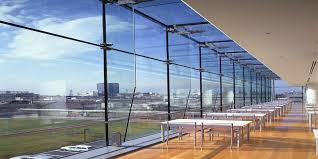Float Glass Introduction

Glass cutting machine with labeling function for America customer
03/08/2018
Welcome to CHINA GLASS 2018 Exhibition
04/08/2018
Float glass is a sheet of glass made by floating molten glass on a bed of molten metal, typically tin, although lead and various low melting point alloys were used in the past. This method gives the sheet uniform thickness and very flat surfaces.
Modern windows are made from float glass. Most float glass is soda-lime glass, but relatively minor quantities of specialty borosilicate[2] and flat panel display glass are also produced using the float glass process.[3] The float glass process is also known as the Pilkington process, named after the British glass manufacturer Pilkington, which pioneered the technique (invented by Sir Alastair Pilkington) in the 1950s at their production site in St Helens, Merseyside.
The molten glass is fed into a "tin bath", a bath of molten tin (about 3–4 m wide, 50 m long, 6 cm deep), from a delivery canal and is poured into the tin bath by a ceramic lip known as the spout lip.[9] The amount of glass allowed to pour onto the molten tin is controlled by a gate called a tweel.
Tin is suitable for the float glass process because it has a high specific gravity, is cohesive, and is immiscible with molten glass. Tin, however, oxidises in a natural atmosphere to form tin dioxide (SnO2). Known in the production process as dross, the tin dioxide adheres to the glass. To prevent oxidation, the tin bath is provided with a positive pressure protective atmosphere of nitrogen and hydrogen.
The glass flows onto the tin surface forming a floating ribbon with perfectly smooth surfaces on both sides and of even thickness. As the glass flows along the tin bath, the temperature is gradually reduced from 1100 °C until at approximately 600 °C the sheet can be lifted from the tin onto rollers. The glass ribbon is pulled off the bath by rollers at a controlled speed. Variation in the flow speed and roller speed enables glass sheets of varying thickness to be formed. Top rollers positioned above the molten tin may be used to control both the thickness and the width of the glass ribbon.
Once off the bath, the glass sheet passes through a lehr kiln for approximately 100 m, where it is cooled gradually so that it anneals without strain and does not crack from the temperature change. On exiting the "cold end" of the kiln, the glass is cut by machines.
Today, float glass is the most widely used form of glass in consumer products. Due to both its high quality with no additional polishing required and its structural flexibility during production, it can easily be shaped and bent into a variety of forms while in a heated, syrupy state. This makes it ideal for a variety of applications such as
Automobile glass (e.g. windshields, windows, mirrors)
Mirrors
Furniture (e.g. in tables and shelves)
Insulated glass
Windows and doors
Most forms of specialized glass such as toughened glass, frosted glass, laminated safety glass and soundproof glass consist of standard float glass that has been further processed.
Modern windows are made from float glass. Most float glass is soda-lime glass, but relatively minor quantities of specialty borosilicate[2] and flat panel display glass are also produced using the float glass process.[3] The float glass process is also known as the Pilkington process, named after the British glass manufacturer Pilkington, which pioneered the technique (invented by Sir Alastair Pilkington) in the 1950s at their production site in St Helens, Merseyside.
Manufacture
Float glass uses common glass-making raw materials, typically consisting of sand, soda ash (sodium carbonate), dolomite, limestone, and salt cake (sodium sulfate) etc. Other materials may be used as colourants, refining agents or to adjust the physical and chemical properties of the glass. The raw materials are mixed in a batch process, then fed together with suitable cullet (waste glass), in a controlled ratio, into a furnace where it is heated to approximately 1500 °C. Common flat glass furnaces are 9 m wide, 45 m long, and contain more than 1200 tons of glass. Once molten, the temperature of the glass is stabilised to approximately 1200 °C to ensure a homogeneous specific gravity.The molten glass is fed into a "tin bath", a bath of molten tin (about 3–4 m wide, 50 m long, 6 cm deep), from a delivery canal and is poured into the tin bath by a ceramic lip known as the spout lip.[9] The amount of glass allowed to pour onto the molten tin is controlled by a gate called a tweel.
Tin is suitable for the float glass process because it has a high specific gravity, is cohesive, and is immiscible with molten glass. Tin, however, oxidises in a natural atmosphere to form tin dioxide (SnO2). Known in the production process as dross, the tin dioxide adheres to the glass. To prevent oxidation, the tin bath is provided with a positive pressure protective atmosphere of nitrogen and hydrogen.
The glass flows onto the tin surface forming a floating ribbon with perfectly smooth surfaces on both sides and of even thickness. As the glass flows along the tin bath, the temperature is gradually reduced from 1100 °C until at approximately 600 °C the sheet can be lifted from the tin onto rollers. The glass ribbon is pulled off the bath by rollers at a controlled speed. Variation in the flow speed and roller speed enables glass sheets of varying thickness to be formed. Top rollers positioned above the molten tin may be used to control both the thickness and the width of the glass ribbon.
Once off the bath, the glass sheet passes through a lehr kiln for approximately 100 m, where it is cooled gradually so that it anneals without strain and does not crack from the temperature change. On exiting the "cold end" of the kiln, the glass is cut by machines.
Uses
A float glass light fitting. Ordinary float glass is green in thicker sheets due to Fe2+ impurities.Today, float glass is the most widely used form of glass in consumer products. Due to both its high quality with no additional polishing required and its structural flexibility during production, it can easily be shaped and bent into a variety of forms while in a heated, syrupy state. This makes it ideal for a variety of applications such as
Automobile glass (e.g. windshields, windows, mirrors)
Mirrors
Furniture (e.g. in tables and shelves)
Insulated glass
Windows and doors
Most forms of specialized glass such as toughened glass, frosted glass, laminated safety glass and soundproof glass consist of standard float glass that has been further processed.
